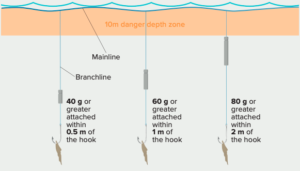Line Weighting
WHAT IS LINE WEIGHTING?
Seabirds are at risk of becoming hooked and drowned when foraging in the ocean, during the short period between when hooks leave the vessel and when they sink beyond seabirds’ diving ranges. Line weighting is the process whereby weights are added to branch lines (snoods) in pelagic and demersal longline fisheries, in order to quickly sink hooks to target fishing depths beyond the diving range of seabirds. A sink rate of 0.3m/s is desirable.
The sink rate of a hook is dependent on the mass of the attached weight, and the distance between the weight and the hook. Heavier weights, placed closer to the hook, are the most effective at quickly sinking baited hooks.
Increasing the number of hooks between floats along a longline can also act to weigh the line down, although variables such as ocean currents and specific gear design will affect the maximum depth that can be achieved with this.
Line weighting is most effective when used in conjunction with night setting and bird-scaring lines, and lines should be weighted to sink beneath the protection of bird-scaring lines.

Source: ACAP
CURRENT RESEARCH & USE
Line weighting is widely used and accepted as an effective measure to reduce incidental catch of seabirds in demersal and pelagic longline fisheries. It is a recommended best practice by the Agreement for Conservation of Albatrosses and Petrels (ACAP), and may have contributed to reducing bycatch of albatross and petrels in the South Georgia Patagonian toothfish fishery.
Trials conducted in a Pacific Ocean pelagic longline tuna fishery with a high rate of albatross bycatch found that, in combination with night-time setting, fishing deeper by adding more hooks between each float achieved >99% lower albatross and total seabird bycatch rates, in comparison to deep and shallow partial day-time sets. Tuna catch rates were unaffected by setting at night.
The newest innovation is to build the weight into the hook itself (a “weighted hook” or “heavy hook”) rather than the branchline. A collaboration in New Zealand is currently trialling this design, named the ‘Procella 2.0’ hook. Fishermen participating in the trial have so far been highly positive about the hook.
Tailoring line weighting to different fisheries
Recommended line weighting regimes differ across pelagic and longline fisheries, depending on the type and configuration of fishing gear. In pelagic longline fisheries, ACAP recommends a weight of 40g within 0.5m of the hook, 60g within 1m, and 80g within 2m. For a comprehensive overview of different weighting regimes, see the ACAP Factsheets listed below. The optimal sink rate is considered to be 0.3 m/sec, with weight evenly distributed along the entire line. If weights are too far apart, this may cause the hook line to initially “loft” and increase the risk of bycatch. The type of weight and material used in the manufacture of line has also been recognised as affecting sink rates in real-life situations (as opposed to controlled lab conditions), with ACAP’s Seabird Bycatch Working Group recommending in August 2024 that ACAP define specifications to ensure that weights perform at sea as intended.
UK applicability
The Joint Nature Conservation Committee (JNCC) has reported on use of line weighting in UK longline fisheries, with research currently ongoing to determine optimum gear configurations. A 2024 modelling exercise synthesised evidence from the use of line weighting by pelagic longlines. It found that while all weighting designs had potential to significantly reduce seabird bycatch, the two most effective designs involved the use of >60g weights placed between >1 m and ≤3.5 m from the hook.
Current drawbacks
The main problem associated with line weighting is ‘fly backs’, which occur when weights fly back toward the vessel after line breakages or bite offs, endangering crew members onboard. Sliding leads greatly reduce this risk. Research and development for new branchline configurations and safety devices to protect fishers was recently undertaken in Australia, although results from this work have yet to be published.
Other issues include the upwelling created by propeller wash at the stern of the vessel, which reduces sink rate. Lines should thus be cast beyond the propeller wash, but still under the protection of bird-scaring lines. Rough seas can also keep lines close to the surface, exposing baited hooks in troughs of waves.
Interested in how this and other measures could mitigate bycatch in your fishery? Get in touch with us to collaborate or take part in a study.
This page was last updated on 03.07.25.
